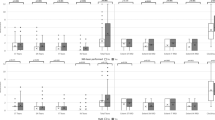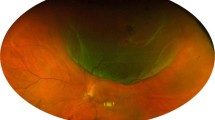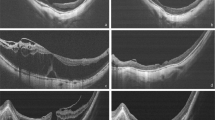Abstract
Background/Objectives
To compare the efficacy of intraoperative localized and 360° laser retinopexy in cases of rhegmatogenous retinal detachment (RRD) treated with pars plana vitrectomy and air tamponade.
Subjects/Methods
In this interventional, prospective, randomized, comparative study, 93 consecutive cases of RRD were enroled. After randomization 48 eyes received circumferential, while 45 underwent localized intraoperative laser retinopexy. Number and position of the retinal breaks, presence of proliferative vitreoretinopathy and/or lattice degeneration were recorded. Anatomical and visual outcome of the two groups were compared at 6 months postoperatively.
Results
Baseline characteristics did not significantly differ between groups. The single-operation reattachment rate was 86.66% in localized group and 89.58% in 360° group. The difference was not significant. (P = 0.46, χ2 test). At 6 months postoperatively, visual acuity (logMAR) was 0.06 ± 0.05 in localized group and 0.05 ± 0.03 in 360° group. The difference was not statistically significant (P = 0.673, t-test).
Conclusions
Localized laser resulted to be as effective as 360° laser application; this may lead some advantages in term of lower invasiveness, reduction risk of complications and time saving.
Similar content being viewed by others
Introduction
Rhegmatogenous retinal detachment (RRD) is a serious and sight-threatening condition in which neurosensory retina separates from the retinal pigment epithelium and is associated with retinal ruptures that allow vitreous to accumulate in sub-retinal space.
At present, pars plana vitrectomy (PPV) is the most frequently performed technique for the treatment of RRD [1, 2]. Its increasing use in recent years is attributable to various factors resulting from technological progress, including improvements in fluid dynamics, the production of small-gauge instrumentation and the commercialization of intraocular tamponades (perfluorocarbon liquid, silicone oils and gases).
Laser photocoagulation is commonly used to ensure adherence between retinal pigment epithelium and neurosensory retina [3]. Circumferential argon laser photocoagulation was also performed for the prevention of retinal detachment in eyes with lattice degeneration and/or retinal breaks [4].
During retinal detachment surgery, once the retinal breaks have been identified and the retina has been reattached, the surgeon has two treatment options: to perform extensive 360° laser retinopexy or to apply localized laser photocoagulation just encircling the ruptures, sparing all the remaining retina. Which of the two is the best approach is still a matter of debate and no clear answers have been reported in the literature. We aimed the compared the efficacy of the two techniques and the respective primary success rate.
This is one of the first prospective studies that aimed to compare intraoperative localized and circumferential laser retinopexy in eyes with RRD treated with PPV and air tamponade.
Materials/subjects and methods
In this interventional, prospective, randomized, comparative study, we enroled 93 consecutive patents with RRD who referred to our clinic in the period between June 2017 and November 2018. We received approval by the local Institutional Review Board, Italy (Comitato Etico Area Vasta Nord Ovest, register number: 14898). The study was conducted in adherence to the tenets of the Declaration of Helsinki. Informed consent was obtained from all patients before surgery.
A complete ophthalmologic examination was performed in all subjects, including measurement of intraocular pressure, best-corrected visual acuity (BCVA) and slit-lamp biomicroscopy of the anterior and posterior segments. BCVA measurement was performed using the Early Treatment Diabetic Retinopathy Study visual acuity chart and converted in logarithm of minimum angle of resolution (logMAR) for statistical analysis. Age, sex, systemic disease, systemic therapy, previous ophthalmic surgery, the localization and the extension of the retinal detachment, the localization and the number of the retinal breaks, the macular status and the presence and the grade of proliferative vitreoretinopathy (PVR) were preoperatively recorded. Retinal data were carefully re-checked intraoperatively and updated where appropriate.
Exclusion criteria were prior vitreoretinal surgery; RRD caused by giant retinal tears; undetected retinal breaks after either dynamic scleral depression or scrupulous vitreous base dissection; PVR grade C or worse [5] and ocular disorders that could interfere with visual recovery (e.g. age-related macular degeneration, diabetic retinopathy, glaucoma).
All surgeries were performed by a single surgeon (GC) and included 23 Gauge PPV using the Constellation Ultrahigh-Speed Vitrectomy (Alcon, Fort Worth, TX). A Resight 700 (Carl Zeiss Meditec AG, Jena, Germany) or a BIOM viewing system (Oculus, Wetzlar, Germany) was used for posterior visualization. All eyes received core and peripheral vitrectomy under indentation. Liquid perfluoro carbonate (perfluoro-n-octane, Al.chi.mi.a. S.r.l., Ponte S. Nicolò, Padova, Italy) was injected. In case of PVR, it was carefully removed using Tano tip and end-grip forceps. After fluid–air exchange, laser photocoagulation was applied according to randomization using the PUREPOINT® Laser 532 nm integrated in the Constellation machine (Alcon, Fort Worth, TX). In localized group two row of laser spots were performed encircling the ruptures and/or the degeneration area. In 360° group, laser retinopexy was performed as in localized group. In addition, two rows of laser spots were applied in a circumferential manner, delimiting a new ora serrata, posterior to the natural one. In phakic patients phacovitrectomy was performed.
The randomization was made intraoperatively, after fluid–air exchange, using an online statistical computing web program (http://www.graphpad.com/quickcalcs/index.cfm). The surgeon (GC) and his second operator (PL) were unmasked; PL performed randomization. At each follow-up visits, the examiners (AM, FS and CP) were masked.
The need for further operations (vitrectomy, scleral buckle or both) over the follow-up period was recorded. Anatomic recovery and visual acuity at 6 months postoperatively were the main outcomes.
Statistical analysis was performed using SPSS software (version 20 for Windows, SPSS Inc., Chicago, IL, USA). Sample size was calculated a priori and indicated that 42 subjects were required for each group, with a power of 80% and a significance level of 0.05. Considering a 10% drop out rate, 93 subjects were enroled for this study. Data were reported as the mean ± standard deviation or n (%). Baseline and postoperative measures of the two groups were compared using either the χ2 test and Fisher’s exact test (categorical factors) or Student’s t test (continuous factors). Significance was determined as P < 0.05.
Results
A total of 150 patients affected by RRD were screened; 93 eyes of 93 subjects met the inclusion criteria and were enroled for this investigation. A total of 45 cases (48.38%) were treated with localized and 48 (51.61%) with circumferential laser retinopexy. The mean follow-up was 7.75 ± 1.42 months. Patients and preoperative characteristics are summarized in Table 1. The macula was detached in 38 eyes (40.86%); an involvement of inferior quadrants was detected in 32 cases (34.40%) and phakic patients were 28 (30.10%). We found no significant differences regarding patient age, gender, right or left distribution, involvement of inferior retinal quadrants, macular status, number of retinal breaks, lens status, number of retinal breaks and presence of PVR between the two groups.
The single-operation reattachment rate was 86.66% in group 1 (localized laser) and 89.58% in group 2 (360° laser). The difference was not significant. (P = 0.46, χ2 test).
All subjects experienced an increase in BCVA. At 6 months postoperatively, visual acuity was 0.06 ± 0.05 logMAR in group 1 and 0.05 ± 0.03 logMAR in group 2. The difference was not statistically significant (P = 0.673, t-test).
Postoperative macular oedema was the most frequent complication. This occurred in two cases (4.44%) in the selective-laser group and in two cases (4.16%) in the other group. This difference was not statistically significant (P = 0.96, Fisher’s exact test). No other complications were observed.
The influence of potential risk factors predicting surgery success was displayed in Table 2. It appeared that type of laser retinopexy, lens status, involvement of inferior quadrants, macular status, presence of PVR and number of retinal breaks did not significantly influence the rate of success.
Discussion
Laser application in commonly used by the ophthalmologist to strengthen the adhesiveness between retinal pigment epithelium and neurosensory retina [6]. Yoon and Marmor found that in case of laser photocoagulation of recently reattached rabbit retina, the adhesive force increased to almost 140% by 24 h and three times normal at 2 weeks [7]. Laser application is therefore considered a useful instrument for the treatment of retinal ruptures or detachments. Some surgeons apply cryopexy for similar purposes. However, interruptions of the blood–retinal barrier may be caused by broad application of cryotherapy, with consequent increased dispersion of retinal pigment epithelium cells and enhanced risk of PVR [6, 8].
Circumferential laser application has been performed both intraoperatively and in prevention of retinal detachment in eyes with predisposing lesions like degeneration areas or retinal breaks. Localized laser administration has the advantage to be less invasive and to reduce operative time. Furthermore, broad intraoperative laser application is considered a risk factor for PVR and may be complicated by choroidal effusion, epiretinal membrane formation, haemorrhage and posterior vitreous detachment with formation of new retinal breaks [9, 10].
In this investigation, the primary reattachment rate was not significantly diverse in eyes who received 360° laser retinopexy if compared with those in which localized laser application was administrated.
Previous papers reported the use of laser retinopexy in retinal detachment management. Zhou et al. in their retrospective comparative study reported a higher primary success rate of circumferential laser application in cases of silicone oil-filled RRDs with undetected retinal ruptures, when compared with localized demarcation laser photocoagulation [11]. Other authors reported the prophylactic use of 360° laser retinopexy to avoid re-detachment after silicone oil removal [12, 13] and after vitrectomy [14] and phacovitrectomy [15]. Of the previously mentioned papers, only one compared localized versus circumferential laser photocoagulation, while in the remaining ones, 360° laser application was compared with no treatment. More recently, Bilgin et al. reported no differences in anatomical and functional outcomes, with or without circumferential endolaser, in cases of RRD using C3F8 gas, SF6 gas or 1000 cSt silicone oil as tamponade, depending by the surgeon choice [16]. We used intraoperative laser photocoagulation as primary treatment, in addition to air tamponade. If compared with long-acting gases like sulfur hexafluoride or octafluoropropane, room air causes less postoperative visual disturbance and limitations in daily activities [17]. Furthermore, a lower possibility of increased intraocular pressure and onset of cataract has been reported in eyes with air tamponade [18].
The presence of retinal breaks was carefully checked intraoperatively, and causative tears were well identified in all cases. This is one of the first papers that compared two patterns of laser application in a similar fashion. Our purpose was to investigate whether there was a need to apply circumferential laser in uncomplicated RRDs. We found that localized laser was equally effective as 360° laser administration, with no need of adjuvant tamponades, except for sterile air.
Potential explanation of the higher success rate of 360° laser retinopexy in previous studies may result from missed tiny retinal breaks and in PVR formation. Retinal breaks, as well as intraoperative laser and cryopexy, may cause the interruption of the blood–retinal barrier [6]. Serum proteins, inflammatory molecules and growth factors spill over into the vitreous cavity and trigger cell migration and proliferation, causing membrane formation in periretinal area [19]. In our case, we performed accurate removal of the peripheral membrane and this may have contributed to improve the success rate.
The type of laser retinopexy did not influence visual outcome, since BCVA did not significantly differ in the two groups.
The present study has some weaknesses including the low number of patients enroled and the restriction to not all cases of retinal detachment.
In conclusion, in this prospective, interventional, randomized, comparative study, intraoperative localized laser resulted to be as effective as 360° laser application in cases of primary RRD treated with PPV and air tamponade. The results of the present paper may lead some advantages in term of lower invasiveness, reduction risk of complications and time saving.
Summary
What was known before
-
Treatment of RRD plana vitrectomy is the most frequently performed technique.
-
Laser photocoagulation ensures adherence between retinal pigment epithelium and neurosensory retina.
What this study adds
-
Circumferential versus localized laser application: localized laser resulted to be as effective as 360° laser application. The type of laser retinopexy did not influence visual recovery.
-
Advantages: lower invasiveness, reduction risk of complications and time saving.
References
Schwartz SG, Flynn HW Jr., Mieler WF. Update on retinal detachment surgery. Curr Opin Ophthalmol. 2013;24:255–61.
Hwang JC. Regional practice patterns for retinal detachment repair in the United States. Am J Ophthalmol. 2012;153:1125–8.
Folk JC, Sneed SR, Folberg R, Coonan P, Pulido JS. Early retinal adhesion from laser photocoagulation. Ophthalmology. 1989;96:1523–5.
Pollack A, Milstein A, Oliver M, Zalish M. Circumferential argon laser photocoagulation for prevention of retinal detachment. Eye. 1994;8:419–22.
Machemer R, Aaberg TM, Freeman HM, Irvine AR, Lean JS, Michels RM. An updated classification of retinal detachment with proliferative vitreoretinopathy. Am J Ophthalmol. 1991;112:159–65.
Jaccoma EH, Conway BP, Campochiaro PA. Cryotherapy causes extensive breakdown of the blood-retinal barrier. A comparison with argon laser photocoagulation. Arch Ophthalmol. 1985;103:1728–30.
Yoon YH, Marmor MF. Rapid enhancement of retinal adhesion by laser photocoagulation. Ophthalmology. 1988;95:1385–8.
Campochiaro PA, Kaden IH, Vidaurri-Leal J, Glaser BM. Cryotherapy enhances intravitreal dispersion of viable retinal pigment epithelial cells. Arch Ophthalmol. 1985;103:434–6.
Pastor JC, de la Rua ER, Martin F. Proliferative vitreoretinopathy: risk factors and pathobiology. Prog Retin Eye Res. 2002;21:127–44.
Azar G, Wolff B, Cornut PL, Mauget-Faysse M. Serous retinal detachment following panretinal photocoagulation (PRP) using Pattern Scan Laser (PASCAL) photocoagulator. GMS Ophthalmol Cases. 2012;2:Doc01.
Zhou C, Zheng Z, Qiu Q. Pars plana vitrectomy with 360 degrees versus localized laser retinopexy in the management of retinal detachment with undetected breaks intraoperatively: a retrospective, comparative, interventional study. Lasers Med Sci. 2017;32:583–9.
Avitabile T, Longo A, Lentini G, Reibaldi A. Retinal detachment after silicone oil removal is prevented by 360 degrees laser treatment. Br J Ophthalmol. 2008;92:1479–82.
Laidlaw DA, Karia N, Bunce C, Aylward GW, Gregor ZJ. Is prophylactic 360-degree laser retinopexy protective? Risk factors for retinal redetachment after removal of silicone oil. Ophthalmology. 2002;109:153–8.
Koh HJ, Cheng L, Kosobucki B, Freeman WR. Prophylactic intraoperative 360 degrees laser retinopexy for prevention of retinal detachment. Retina. 2007;27:744–9.
Iwase T, Jo Y-J, Oveson BC. Effect of prophylactic 360° laser treatment for prevention of retinal detachment after phacovitrectomy: (prophylactic 360° laser treatment for prevention of retinal detachment). BMC Ophthalmol. 2013;13:77.
Bilgin AB, Dogan ME, Aysun B, Apaydin KC. Pars plana vitrectomy with or without intraoperative 360 degrees peripheral endolaser for rhegmatogenous retinal detachment treatment. Int Ophthalmol. 2019;39:1687–94.
Thompson JT. Kinetics of intraocular gases. Disappearance of air, sulfur hexafluoride, and perfluoropropane after pars plana vitrectomy. Arch Ophthalmol. 1989;107:687–91.
Tetsumoto A, Imai H, Hayashida M, Otsuka K, Matsumiya W, Miki A, et al. The comparison of the surgical outcome of 27-gauge pars plana vitrectomy for primary rhegmatogenous retinal detachment between air and SF6 gas tamponade. Eye. 2019. https://doi.org/10.1038/s41433-41019-40726-41432.
Wiedemann P. Growth factors in retinal diseases: proliferative vitreoretinopathy, proliferative diabetic retinopathy, and retinal degeneration. Surv Ophthalmol. 1992;36:373–84.
Author information
Authors and Affiliations
Corresponding author
Ethics declarations
Conflict of interest
The authors declare that they have no conflict of interest.
Additional information
Publisher’s note Springer Nature remains neutral with regard to jurisdictional claims in published maps and institutional affiliations.
Rights and permissions
About this article
Cite this article
Loiudice, P., Montesel, A., Sartini, F. et al. Localized versus 360° intraoperative laser retinopexy in cases of rhegmatogenous retinal detachment with mild-to-moderate grade proliferative vitreoretinopathy. Eye 35, 786–790 (2021). https://doi.org/10.1038/s41433-020-0950-9
Received:
Revised:
Accepted:
Published:
Issue Date:
DOI: https://doi.org/10.1038/s41433-020-0950-9
This article is cited by
-
360-Degree laser retinopexy in primary vitrectomy for rhegmatogenous retinal detachment: factors associated with its use and impact on surgical outcomes
International Journal of Retina and Vitreous (2022)
-
Comment on: Localized versus 360° intraoperative laser retinopexy in cases of rhegmatogenous retinal detachment with mild-to-moderate grade proliferative vitreoretinopathy
Eye (2021)
-
Reply to: Comment on: Localized versus 360° intraoperative laser retinopexy in cases of rhegmatogenous retinal detachment with mild-to-moderate grade proliferative vitreoretinopathy
Eye (2021)



